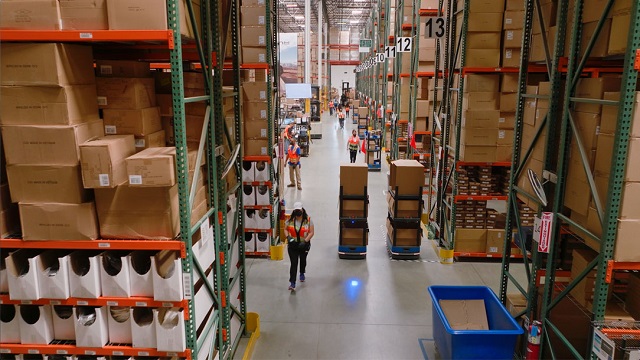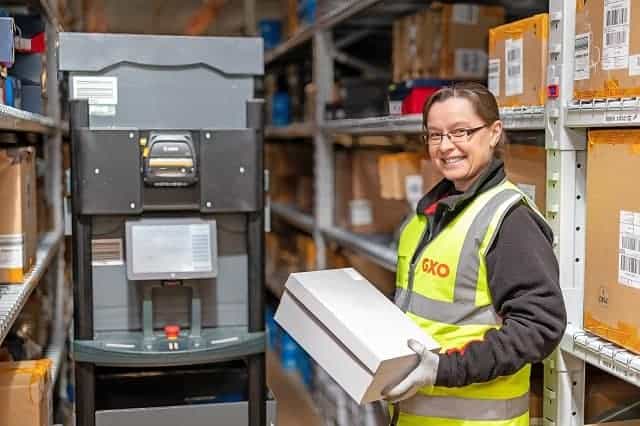The drive to create competitive advantage and increase delivery speed is leading to numerous breakthroughs in logistics technology. Warehouses, being important hubs in the supply chain, are under pressure to keep up with technology trends to keep pace with demand.

Today, we will examine six of the leading logistics technologies that are driving warehouse operations trends and capability improvements:
- Drone deliveries are adding last-minute delivery capabilities.
- RFID tags are expanding inventory visibility.
- GPS capability is enabling real-time shipment tracking.
- Artificial Intelligence technology is boosting pick efficiency and accuracy.
- Automation-as-a-Service is allowing operations to scale as demand shifts.
- On-demand warehousing is optimizing factory space utilization.
Here’s how these logistics technologies and trends are shaping the warehouse industry.
1. Drone deliveries are adding last-minute delivery capabilities
Retailers and e-commerce companies continue to compete for market share with two-day, next-day and same-day delivery offerings. Demand for rapid delivery has led to an increased interest in the use of drones for last-mile delivery. In turn, warehouses face even more pressure to fulfill orders faster and with greater accuracy in order to keep up with demand.
The push for rapid delivery is also leading to a rise in 3rd-party partnerships that can help companies facilitate rapid delivery. One much-discussed example is Amazon’s partnership with the U.S. Postal Service, which makes deliveries for Amazon on Sundays — the one day of the week the postal service typically does not operate.
2. RFID tags are expanding inventory visibility
With the rise of the Internet of Things (IoT), the idea that “everything is connected” is becoming a reality. The IoT is a boon for the warehouse and logistics industry, providing real-time, accurate visibility into inventory situations, location and the supply chain as a whole.
Recently, the use of active and passive RFID tags has increased the amount of product data that can be accessed remotely for any individual item. With this technology, warehouse operators know where their inventory is and where it’s going in real-time. This advanced location tracking can greatly improve the speed of order processing as it provides a new level of reliability in planning.
3. GPS capability is enabling real-time shipment tracking
By coupling RFID tags with GPS, it is possible to track shipments in real-time (and with greater precision) during transportation. These advancements in GPS-based fleet management provide a consistent, end-to-end view of the logistics delivery channel. Better visibility facilitates improved communication between retailers, distribution centers and end consumers by allowing any and all parts of the distribution chain to access the current location of orders at any given time.
4. Artificial Intelligence technology is boosting pick efficiency and accuracy
The use of collaborative mobile robots brings AI to the warehouse, boosting picking efficiency and accuracy. These mobile warehouse robotics systems, such as 6 River Systems’ Chuck, leverage AI to choose the best picking routes while eliminating long or unnecessary walks in the warehouse. Chuck leads associates to the next task to keep warehouse associates always on an efficient path and focused on the next most important activity.
5. Automation-as-a-Service is allowing operations to scale as demand shifts
Balancing supply and demand is as important as ever, but doing so requires flexibility. The adoption of Automation-as-a-Service technologies is on the rise, allowing warehouses to readily scale resources up or down to accommodate shifts in demand. These systems can provide more flexibility when it comes to managing costs, priority deliveries and distribution channels. For instance, companies like 6 River Systems allow warehouse operators to rent collaborative robots during a peak period and return them when demand returns to baseline levels, avoiding major investments in equipment that would sit idle during non-peak periods.
6. On-demand warehousing is optimizing factory space utilization
Beyond the traditional use of third-party logistics providers (3PLs) is the emergence of on-demand warehousing, which allows companies to access additional warehouse space when and only when they might need it. Like Automation-as-a-Service, on-demand warehousing eliminates the need to invest in permanent warehouse space that isn’t consistently needed. At this same time, it also enables warehouses built for peak capacity to leverage extra space during slower periods.
It’s clear that innovations in logistics technology will continue to have a noticeable impact on the entire supply chain landscape well into the future. Warehouse operators who are able and willing to continually adopt new and effective warehouse capabilities will give themselves an edge in a challenging environment.


